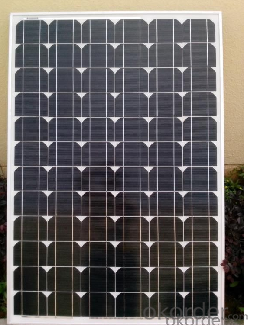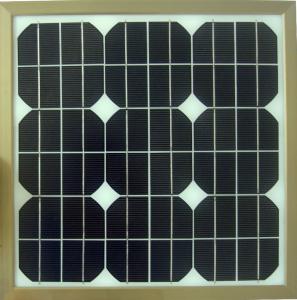Loading Port:China main port
Payment Terms:TT or LC
Min Order Qty:1 pc
Supply Capability:200000000 pc/month
Mono Silicon Solar Panel(85W—100W)
Introduction of Mono Silicon Solar Panel(85W-100W)
Solar photovoltaic (PV) Panel is designed for large electrical power requirements.
It is the optimal choice for both on-grid and off-grid power systems. CNBM Solar panel offers high performance of power per square foot of solar array. Monocrystalline silicon(c-Si): often made using the Czochralski process. Single-crystal wafer cells tend to be expensive, and because they are cut from cylindrical ingots, do not completely cover a square solar cell module without a substantial waste of refined silicon. Hence most c-Si panels have uncovered gaps at the four corners of the cells.
2.Characteristics of Mono Silicon Solar Panel
I Solar Cell : High efficiency crystalline solar cell. Even if under the weak light, the solar module can produce maximum power output.
II Tempered glass (toughened glass): Anti-reflecting coating and high transmission rate glass increase the power output and mechanical strength of solar module.
III EVA and TPT: Using high quality EVA and TPT to prevent destroying and water
IV AI frame: Without screw, corner connection. 6 holes on the frame can be installed easily.
V Junction box: Multi function junction box with water proof.
VI Long lifetime: ≥25 years; Less power decrease.
VII Good performance of preventing from atrocious weather such as wind and hails.
VIII Resisting moisture and etching effectively, not effected by geology.
3.Standard Test Conditions of Mono Silicon Solar Panel
The opto-electrical specifications shown below are stabilized values being measured at Standard Test Conditions, Irradiance: 1000W/m2, Spectrum: AM1.5 at 25°C, The info below is subject to manufacturing tolerances. Where appropriate minutes of measurement are available and are used for the dimensioning of the installation.
4.Images:

5.What's the advantages of your products?
Advantages of Mono Silicon Solar Panel
• CNBM Solar performance guarantees for 25 years
• 2 years guarantee for workmanship
• Timeliness of delivery
CNBM International Corporation's products including Monocrystalline Solar Panel, Polycrystalline Solar Panel have received and enjoyed famous reputation in many countries and regions in the world .As a solar panel supplier in China, we strive to provide our customers with excellent service, superior products and unmatched value.
Max Power Voltage Vmp (V) | 17.8V | 18.0V | 18.2V | 18.4V |
Max Power Current Imp (A) | 4.78A | 5.00A | 5.22A | 5.43A |
Open Circuit Voltage Voc (V) | 22.4V | 22.6V | 22.8V | 23.0V |
Short Circuit Current Isc (A) | 5.13A | 5.31A | 5.56A | 5.89A |
Max Power Pm (W) | 85W | 90W | 95W | 100W |
Temperature Coefficient of Cells
NOCT | 47℃±2℃ |
Temperature Coefficients of Isc (%/℃) | 0.064 |
Temperature Coefficients of Voc (%/℃) | -0.33 |
Temperature Coefficients of Pmp (%/℃) | -0.45 |
Mechanical Data Mono Silicon Solar Panel
Power | 85W/90W/95W/100W |
Dimension | 1190×550×30mm |
Weight | 8kg |
Tolerance | ±3% |
The dimension of the modules can be changed according to the demand of clients
Limits
Operating Temperature | –40 °C to +85°C |
Storage Temperature | –40 °C to +85°C |
Max System Voltage | 700V |
Guarantee of Mono Silicon Solar Panel
Products Guarantee | 2 yrs free from defects in materials and workmanship |
Performance Guarantee | No less than 90% within 10yrs and no less than 80% within 20yrs |
Certificates | IEC, ISO, TUV, CE |
Solar cell technologies
New ‘black diamond’ technology which can double solar cell efficiency
Black diamond’ is an innovative concept that promises to change the future of solar technology, potentially exceeding 50 per cent efficiency in solar concentration systems. Diamonds satisfy two of the three conditions necessary for solar radiation capture – being able to withstand extremely high temperatures, and having the ability to emit electrons efficiently – but, because of their transparency, they are unable to adequately interact with sunlight. The team’s creation of the ‘black diamond’ fulfils this third condition and can harness solar radiation at temperatures up to 1000 °C, according to the researchers.
Next Energy Technologies Turning Windows into Solar Panels
The next time you walk by an office building or are inside looking out, pay close attention to the windows. Chances are they’re heavily tinted to reduce computer glare and to absorb heat, helping the building to stay cooler. In fact, many windows block half the sunlight entering a room, reflecting the rest of the solar energy back into the world. The small-molecule technology is based on organic semiconductors pioneered at UCSB under Alan Heeger, who won a Nobel Prize for his work in 2000. The window arrays will act just like a big solar field, connected in a grid attached to a power inverter. Some day down the line, the ink may be printed on flexible materials such as tents or awnings, or incorporated into roof materials. It may also be used for lightweight, portable generation in developing countries.
Advances in crystalline silicon solar cell technology for industrial mass production
Crystalline silicon photovoltaic (PV) cells are used in the largest quantity of all types of solar cells on the market, representing about 90% of the world total PV cell production in 2008. Crystalline silicon solar cells are also expected to have a primary role in the future PV market. We can learn the current technologies used for the production and application of crystalline silicon PV cells. The highest energy conversion efficiency reported so far for research crystalline silicon PV cells is 25%. Standard industrial cells, however, remain limited to 15–18% with the exception of certain high-efficiency cells capable of efficiencies greater than 20%. High-efficiency research PV cells have advantages in performance but are often unsuitable for low-cost production due to their complex structures and the lengthy manufacturing processes required for fabrication. Various technologies for mono- and polycrystalline PV cells are compared and discussed with respect to the corresponding material technologies, such as silicon ingot and wafer production. High energy conversion efficiency and low processing cost can only be achieved simultaneously through the development of advanced production technologies and equipment, and some of the latest technologies that could lead to efficiencies of greater than 25% and commercially viable production costs are reviewed.



